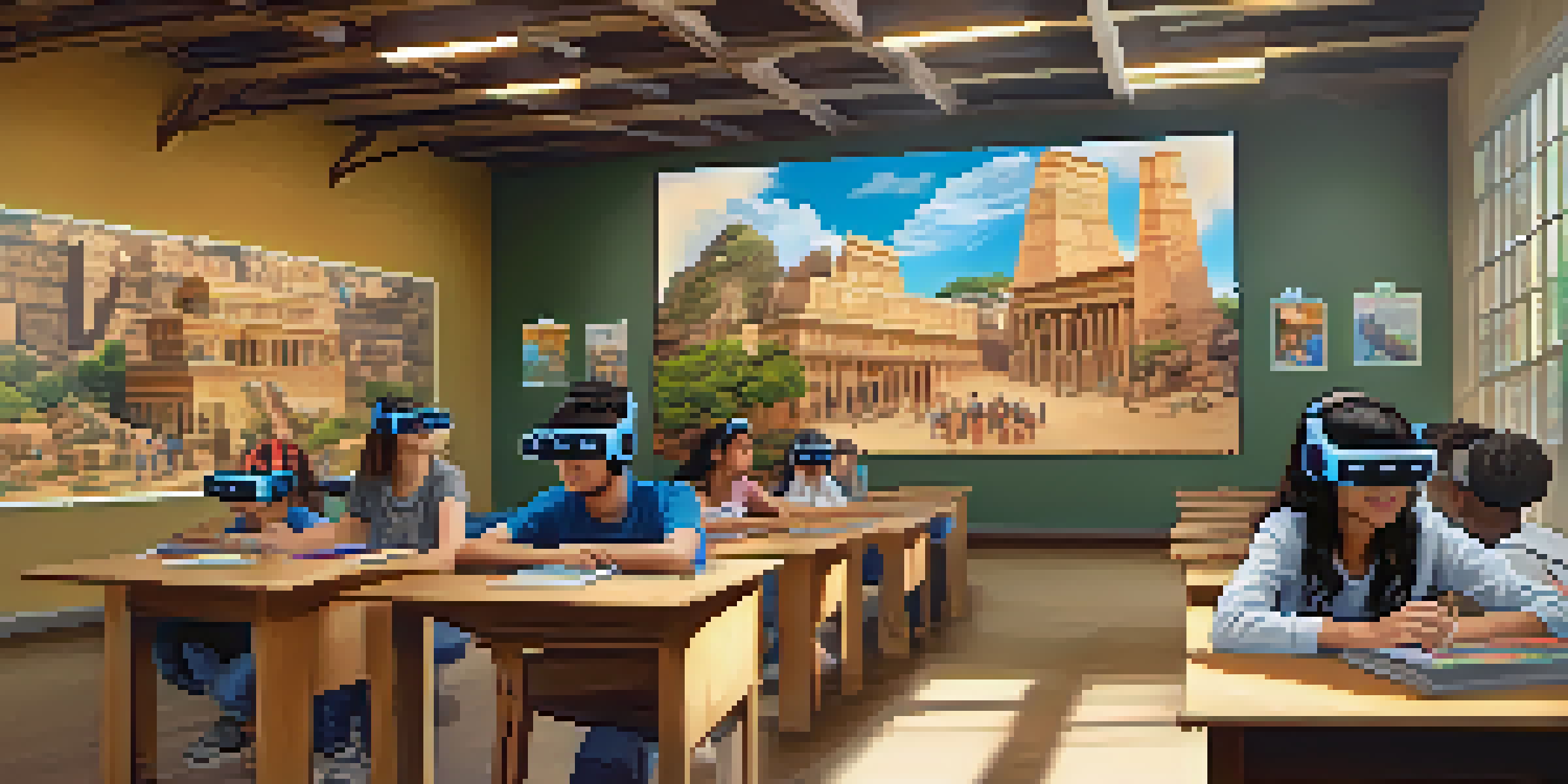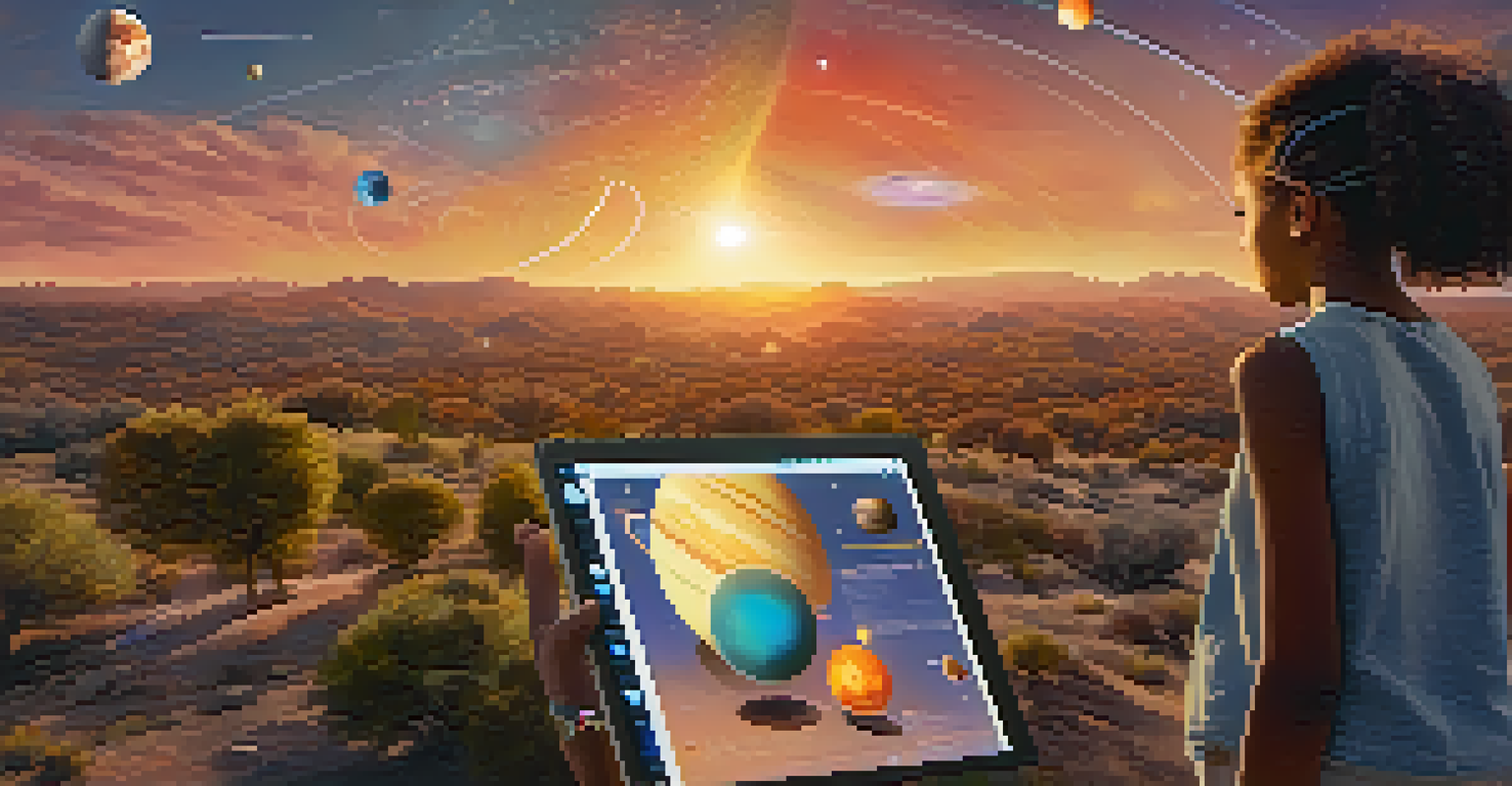AI-Powered Virtual Reality for Immersive Learning Experiences

Understanding AI and Virtual Reality in Education
Artificial Intelligence (AI) and Virtual Reality (VR) are two powerful technologies reshaping education. AI enhances learning processes by personalizing content based on student performance, while VR immerses users in interactive environments that stimulate engagement and retention. Together, they create a unique learning experience that can adapt in real time to student needs. Imagine learning about ancient civilizations by walking through a virtual replica of a historic city—this is the magic of AI-powered VR.
The great thing about technology is that it allows us to rethink the way we teach and learn, making education more accessible and engaging for everyone.
In this blended approach, AI algorithms analyze how students interact with VR scenarios, enabling tailored feedback and support. For instance, if a student struggles with a concept in a VR simulation, AI can suggest additional resources or modify the virtual environment to reinforce learning. This level of personalization not only boosts comprehension but also keeps learners motivated. The integration of these technologies ensures that education is not just informative but also captivating.
As we explore further, it’s essential to recognize the vast potential of these tools in various educational settings. From primary schools to corporate training environments, AI-powered VR can offer immersive simulations that enhance practical skills. For example, medical students can practice surgeries in a risk-free environment, gaining hands-on experience that textbooks alone cannot provide.
The Role of AI in Enhancing VR Learning Experiences
AI plays a crucial role in optimizing the VR learning experience by offering personalized pathways for each learner. Through machine learning, AI can identify patterns in how students engage with the material and adjust the difficulty level accordingly. This adaptive learning model means that no two educational journeys are the same, allowing students to progress at their own pace. Imagine a student mastering a concept faster because the system dynamically adjusts the challenges based on their performance.

Moreover, AI can analyze vast amounts of data to predict outcomes and tailor content that appeals to individual learning styles. For instance, a visual learner might benefit more from graphical representations in VR, while an auditory learner may prefer narrated content. By understanding these preferences, AI can ensure that students are not just passive viewers but active participants in their education. This creates a more engaging and effective learning environment.
AI Personalizes Learning Paths
AI analyzes student interactions to tailor educational content and feedback, enhancing engagement and comprehension.
Additionally, the feedback loop created by AI in VR allows educators to gain insights into student performance and engagement levels. Teachers can track progress in real-time, making it easier to identify areas where students may need additional support or resources. This data-driven approach helps create a more responsive and responsible educational ecosystem, ensuring that every student can thrive.
Creating Engaging Content for Immersive Learning
Engaging content is at the heart of effective immersive learning experiences. With AI-powered VR, educators can design interactive scenarios that captivate students’ attention and foster deeper understanding. For instance, rather than reading about the water cycle, students can experience it firsthand by navigating through a virtual environment where they can observe evaporation, condensation, and precipitation in action. This experiential learning approach encourages curiosity and exploration.
Virtual reality is the first step in a grand adventure into the landscape of the imagination.
Moreover, content creation can be driven by the interests and feedback of the learners themselves. AI can analyze which topics generate the most engagement and suggest new scenarios or expansions based on this data. This not only keeps the material relevant but also empowers students to take an active role in their learning journey. By incorporating their preferences, the educational experience feels more personalized and meaningful.
Furthermore, collaboration is key in developing immersive content. Educators, content creators, and technologists can work together to produce high-quality VR experiences that align with educational standards. By leveraging AI to facilitate this collaboration, teams can streamline content creation processes and ensure that the final product meets the diverse needs of learners across various disciplines.
The Benefits of Immersive Learning with AI and VR
AI-powered VR offers numerous benefits that traditional learning methods often struggle to provide. One significant advantage is the ability to engage learners through immersive experiences that stimulate multiple senses. This multisensory approach can enhance memory retention, making it easier for students to recall information when needed. Think about how much easier it is to remember a vivid experience compared to a lecture—it’s the difference between seeing a movie and reading a script.
Another benefit is the opportunity for experiential learning without the associated risks. For example, students can practice emergency response scenarios in a controlled virtual environment, allowing them to make mistakes and learn from them without real-world consequences. This hands-on practice fosters confidence and competence, preparing learners for real-life challenges they may face in their careers or personal lives.
VR Delivers Immersive Experiences
Virtual reality offers hands-on learning opportunities that allow students to explore concepts in risk-free, interactive environments.
Additionally, immersive learning environments can cater to diverse learning needs and preferences. Students who may struggle in traditional classroom settings can thrive in VR, where they can learn at their own pace, revisit challenging concepts, and engage with the material in a way that suits them best. This inclusivity is vital for fostering a positive learning environment where every student feels valued and empowered.
Challenges in Implementing AI-Powered VR in Education
While the benefits of AI-powered VR are compelling, there are challenges to consider in its implementation. One major hurdle is the cost associated with high-quality VR equipment and software development. Many educational institutions, especially those in underserved areas, may find it difficult to allocate budgets for this technology. However, as the technology becomes more mainstream, costs are likely to decrease, making it more accessible for all.
Another challenge is the need for proper training for educators. Integrating AI and VR into the classroom requires a shift in teaching methodologies and a solid understanding of how to leverage these tools effectively. Professional development programs must be in place to equip teachers with the necessary skills and confidence to utilize AI-powered VR in their instruction. Without this support, the technology may not reach its full potential in enhancing learning experiences.
Lastly, there's the concern of data privacy and security. As AI collects and analyzes data on student interactions, it's crucial to ensure that this information is handled responsibly and ethically. Educators and institutions must prioritize the protection of student data to build trust and ensure compliance with regulations. Addressing these challenges head-on will be essential for successfully integrating AI-powered VR into the educational landscape.
Future Trends in AI and Virtual Reality for Learning
Looking ahead, the future of AI-powered VR in education appears bright, with several trends on the horizon. One exciting development is the increasing use of augmented reality (AR) alongside VR. While VR immerses learners in a fully virtual environment, AR overlays digital information onto the real world, creating a hybrid experience that can enhance learning. Imagine being able to visualize the solar system in your backyard while learning about celestial bodies—this combination could revolutionize how students interact with content.
Moreover, advancements in AI are expected to foster even more personalized learning experiences. As algorithms become more sophisticated, they will be able to predict and adapt to individual students’ needs with greater accuracy. This means that learners can expect more tailored content and support, creating a truly customized educational experience. The goal is to make learning not just effective but also enjoyable and engaging.
Collaboration Enhances Content Creation
By fostering collaboration among educators and technologists, AI-powered VR can produce high-quality, relevant learning experiences.
Additionally, collaboration and social learning will likely take center stage in the development of AI-powered VR. Future platforms may incorporate features that allow students to work together in virtual environments, fostering teamwork and communication skills. This collaborative aspect could mirror real-world job settings, preparing students for the collaborative nature of the modern workforce. As these technologies evolve, they will continue to transform how we approach education.
Conclusion: Embracing the Future of Learning
In conclusion, AI-powered virtual reality holds immense potential for transforming educational experiences. By harnessing the power of AI and VR, we can create immersive, engaging, and personalized learning environments that cater to diverse student needs. The benefits of this technology extend beyond mere engagement; they foster deeper understanding, skill development, and confidence in learners across various fields.
However, as we embrace these innovations, it’s crucial to address the challenges of implementation, including cost, training, and data privacy. By proactively tackling these issues, educators and institutions can ensure that AI-powered VR becomes an integral part of the learning landscape. The journey toward fully realizing the potential of these technologies is ongoing, but the future looks promising.

Ultimately, the integration of AI and VR in education represents a paradigm shift in how we approach teaching and learning. As we continue to explore and innovate, we will undoubtedly uncover new ways to enhance the educational experience, making it more accessible, engaging, and effective for learners of all ages.